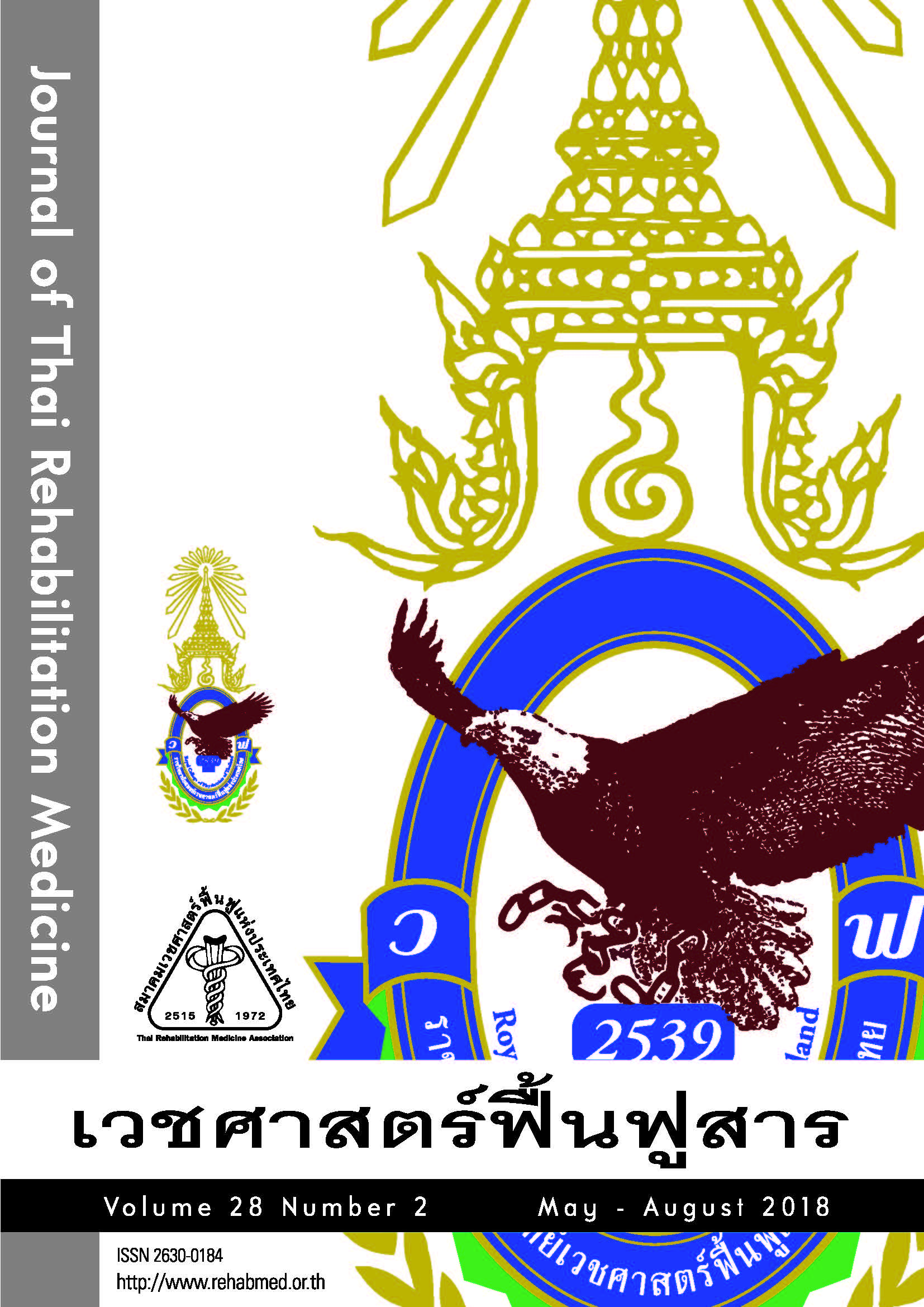การฉีดน้ำเกลือแยกชั้นเยื่อพังผืดระหว่างกล้ามเนื้อโดยใช้เครื่องอัลตราซาวนด์นำเพื่อเป็นทางเลือกหนึ่งในการบำบัดไหล่ติด: การศึกษาย้อนหลัง
การฉีดน้ำเกลือแยกชั้นเยื่อพังผืดระหว่างกล้ามเนื้อโดยใช้เครื่องอัลตราซาวนด์นำเพื่อเป็นทางเลือกหนึ่งในการบำบัดไหล่ติด: การศึกษาย้อนหลัง
Keywords:
adhesive capsulitis, ultrasonography, fascial release with normal saline injectionAbstract
Objective: To report the effect of treating adhesive capsulitis with ultrasound guided fascial release with normal saline.
Study design: Retrospective study.
Setting: Department of Physical Medicine and Rehabilitation, Lerdsin Hospital, Bangkok
Subjects: Twenty-one patients diagnosed with adhesive capsulitis who underwent fascial release by normal saline injection with ultrasound guidance at 4 sites: 1) between levator scapulae and trapezius, 2) between rhomboid major and trapezius, 3) between teres minor and deltoid, and 4) between pectoralis major and deltoid muscles.
Method: Outpatient medical records of the patients were retrospectively reviewed. The outcome measurement was passive range of motions (PROMs) of the affected shoulder before and after injections.
Results: After injections, the shoulder mean PROMs (SD) was statistically significant increased in all directions (flexion: before 125.71 (21.93), after 154.52 (11.06); abduction: before 118.81 (24.64), after 150.95 (18.75); external rotation: before 56.90 (13.37), after 73.10 (9.55); internal rotation: before 24.52 (10.48), after 51.67 (7.30); p<0.001, Wilcoxon signed rank test).
Conclusion: Ultrasound guided fascial release with normal saline could increase shoulder range of motion and be considered as a potential treatment option for adhesive capsulitis.
References
2. Connolly J. Unfreezing the frozen shoulder. J Musculoskel Med. 1998;15:47–58.
3. Hsu JE, Anakwenze OA, Warrender WJ, Abboud JA. Current review of adhesive capsulitis. J Shoulder Elbow Surg. 2011;20:502-4.
4. Dias R, Cutts S, Massoud S. Frozen shoulder. BMJ. 2005;331: 1453-6.
5. Rizk TE, Pinals RS. Frozen shoulder. Semin Arthritis Rheum. 1982;11:440-52.
6. Chan HBY, Pua PY, How CH. Physical therapy in the management of frozen shoulder. Singapore Med J. 2017;58:685-9.
7. Pal B, Anderson J, Dick WC, Griffiths ID. Limitation of joint mobility and shoulder capsulitis in insulin- and non-insulin-dependent diabetes mellitus. Br J Rheumatol. 1986;25:147-51.
8. Cakir M, Samanci N, Balci N, Balci MK. Musculoskeletal manifestations in patients with thyroid disease. Clin Endocrinol (Oxf). 2003;59:162-7.
9. Wohlgethan JR. Frozen shoulder in hyperthyroidism. Arthritis Rheum. 1987;30:936-9.
10. Riley D, Lang AE, Blair RD, Birnbaum A, Reid B. Frozen shoulder and other shoulder disturbances in Parkinson’s disease. J Neurol Neurosurg Psychiatry. 1989;52:63-6.
11. Hannafin J, Chiaia TA. Adhesive capsulitis. Clin Orthop. 2000;372: 95-109.
12. Hand C, Clipsham K, Rees JL, et al. Long-term outcome of frozen shoulder. J Shoulder Elbow Surg. 2008;17:231-6.
13. Bell S, Coghlan J, Richardson M. Hydrodilatation in the management of shoulder capsulitis. Australas Radiol. 2003;47:247-51.
14. Hamdan T, Al-Essa KA. Manipulation under anaesthesia for the treatment of frozen shoulder. Int Orthop. 2003;27:107-9.
15. Pearsall A, Speer KP. Frozen shoulder syndrome: diagnostic and treatment strategies in the primary care setting. Med Sci Sports Exerc. 1998;30:S33–9.
16. Rodríguez-Fuentes I, De Toro FJ, Rodríguez-Fuentes G, de Oliveira IM, Meijide-Failde R, Fuentes-BoqueteIM. Myofascial release therapy in the treatment of occupational mechanical neck pain: a randomized parallel group study. Am J Phys Med Rehabil 2016;95:507-15.
17. Arguisuelas MD, Lisón JF, Sánchez-Zuriaga D, Martínez-Hurtado I, Doménech-Fernández J. Effects of myofascial release in nonspecific chronic low back pain. Spine (Phila Pa 1976). 2017;42:627-34.
18. Ball TM. Structural integration-based fascial release efficacy in systemic lupus erythematosus (SLE): two case studies. J Bodyw Mov Ther. 2011;15:217-25.
19. Day JA, Stecco C, Stecco A. Application of fascial manipulation technique in chronic shoulder pain – anatomical basis and clinical implications. J Bodyw Mov Ther. 2009;13:128-35.
20. Picelli A, Ledro G, Turrina A, Stecco C, Santilli V, Smania N. Effects of myofascial technique in patients with subacute whiplash associated disorders: A pilot study. Eur J Phys Rehabil Med. 2011;47: 561-8.
21. Gordon C, Andrasik F, Birbaumer N. Myofascial triggerpoint release (MRT) for treating chronic shoulder pain: a novel approach. J Bodyw Mov Ther. 2016;20:614-22.
22. Tozzi P, Bongiorno D, Vitturini C. Fascial release effects on patients with non-specific cervical or lumbar pain. J Bodyw Mov Ther. 2011;15:405-16.
23. de Souza A, Sanchotene CG, da Silva Lopes CM, Beck JA, da Silva ACK, Pereira SM, Ruschel C. Acute effect of two self-myofascial release protocols on hip and ankle range of motion. J Sport Rehabil 2017;15:1-21.
24. Markovic G. Acute effects of instrument assisted soft tissue mobilization vs. foam rolling on knee and hip range of motion in soccer players. J Bodyw Mov Ther. 2015;19:690-6.
25. Simons DG, Travell JG, Simon LS. Travell & Simons’ myofascial pain and dysfunction: the trigger point manual. 2nd ed. Baltimore: Williams & Wilkins; 1999.
26. Minagawa H, Miyatake K, Sasahara J, Nakashima Y, Hattori S. Ultrasound guided intervention. The TRMA Midyear Meeting 2016: 2016 Jun. 25; Bangkok; 2016.
27. Ross K, Mehr J, Carothers B, Greeley R, Benowitz I, McHugh L, et al. Outbreak of septic arthritis associated with intra-articular injection at an outpatient practice – New Jersey, 2017. Morb Mortal Wkly Rep. 2017;66:777-9.
28. Jenkins DB. Hollinshead’s functional anatomy of the limbs and back. 6th ed. Philadelphia: W.B. Saunders; 1991.






